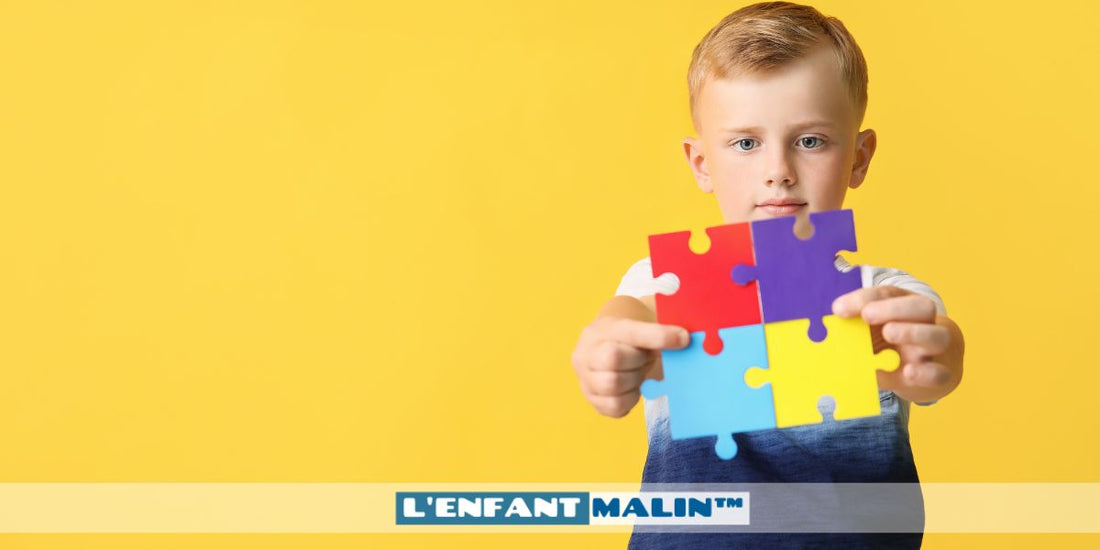1/ Comparison of materials: wood vs cardboard
In the world of educational toys, the puzzle occupies an important place. It promotes awakening, motor skills and development of the child. But when choosing a puzzle for your child, you're faced with a multitude of choices.
- One of the main dilemmas is the choice of material: wood or cardboard?
a. Characteristics of the wood used in puzzles
The wooden puzzle is a traditional toy that has stood the test of time. It is generally preferred for young children and babies due to its sturdiness. Wood is a durable material that resists falls and bites, which is ideal for little ones. Additionally, wooden puzzles are often thicker and easier for little hands to handle, making them more fun and attractive.
b. Characteristics of cardboard used in puzzles
The cardboard puzzle, on the other hand, is lighter and generally more affordable. They usually come with a variety of themes and attractive images, ranging from Disney to animals, which can stimulate the imagination of every child. However, they may be less durable and more difficult for young children to handle.
c. Impact of materials on the durability of puzzles
In terms of durability, the wooden puzzle has a clear advantage. It can last for years and is often passed down from generation to generation. Cardboard, while less durable, offers a greater variety of designs and is often easier to replace if lost or damaged. Ultimately, the choice between wood and cardboard will depend on your child's age, their preferences, and your priorities for durability and cost.

(Credit: lenfantmalin.com - Adult puzzle collection)
2/ Gaming experience: wood vs cardboard
The puzzle is a fun toy which stimulates awareness and contributes to the development of motor skills in young children. Whether in daycare, nursery school or at home, the puzzle is a must-have for early childhood games. Made of wood or cardboard, each puzzle offers a unique and fun experience for your child. But what is the difference between a wooden puzzle and a cardboard puzzle?
a. Touch feeling and handling experience
The wooden puzzle is particularly suitable for toddlers and babies. Thanks to its natural texture and robustness, wood offers a different and often more pleasant tactile sensation for children. It is also easier for little hands to handle, which promotes awareness and the development of motor skills. The cardboard puzzle is lighter and softer to the touch, which may be preferable for some children.
b. Assembly difficulty and challenge level
In terms of assembly difficulty, wooden puzzles are generally simpler and suitable for young children. The wooden pieces are larger and more easily manipulated, which makes the game less frustrating for little ones. Cardboard puzzles often offer a higher level of challenge, with smaller and more pieces, which can be stimulating for older children.
c. Appearance and aesthetics of the finalized puzzle
The appearance and aesthetics of the finalized puzzle may also vary depending on the material. wooden puzzles have a more natural and authentic look, while cardboard puzzles allow for a greater variety of designs and colors. Whether it's a Disney puzzle or a more traditional puzzle, every child will find a puzzle to their liking.
3/ Environmental and safety considerations
When it comes to choosing toys for young children, several factors come into play. In addition to the fun and educational aspect, environmental and safety considerations are increasingly important. Indeed, early childhood is a crucial period for the child's awakening and development, but also for the inculcation of values of respect for the environment.
a. Environmental impact of wood and cardboard
The choice between a wooden puzzle and a cardboard puzzle can have a significant impact on the environment. Wood is a renewable resource, but its production can contribute to deforestation if not managed responsibly. On the other hand, cardboard is often recycled, which reduces its environmental footprint. However, making cardboard puzzles can also consume a lot of energy and contribute to air and water pollution.
b. Safety Considerations for Children
puzzles, whether made of wood or cardboard, must be safe for children. Wooden puzzles are generally more durable and less likely to tear or break, reducing the risk of choking. Cardboard puzzles, on the other hand, are lighter and less likely to cause injury if dropped. It is essential that each toy is appropriate for your child's age and that it meets current safety standards.
c. Recommendations for choosing between a wooden puzzle and a cardboard puzzle
When choosing between a wooden puzzle and a cardboard puzzle, it is recommended to take into account both environmental impact and safety considerations. It can be helpful to look for toys made from durable materials and ensure they are appropriate for your child's age and developmental stage. Ultimately, the most important thing is to choose a puzzle that will be both fun and beneficial to your child's development.
The puzzle is therefore a
